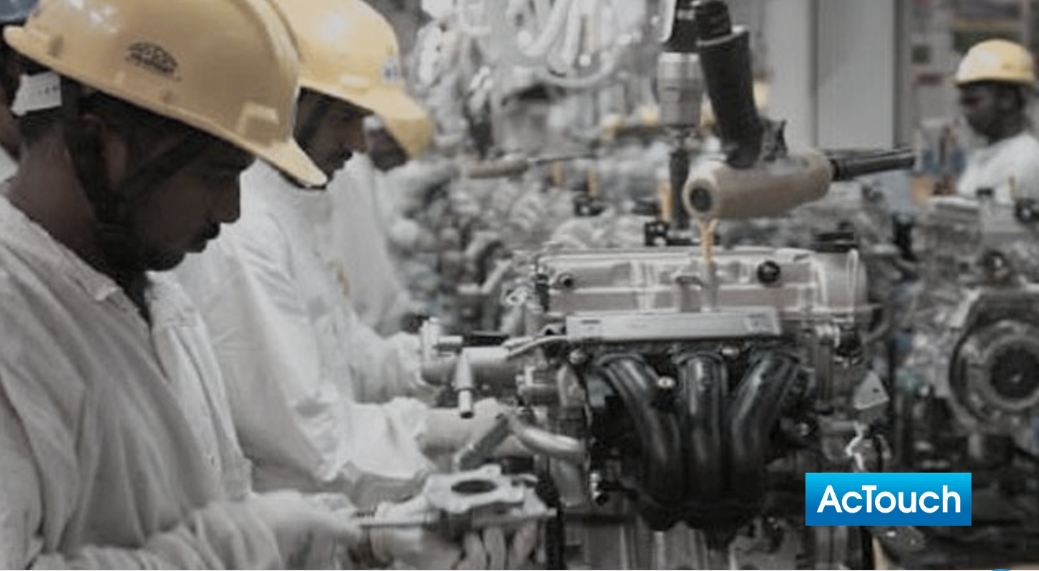Indian Manufacturing Sector and its Problems
It is a known fact that Manufacturing industry is the backbone for any country and it makes difference to its GDP, Employment, Import & Export, Domestic consumption etc. India started its “Make in India” campaign and it is slowly showing the results now. Manufacturing segments helps to improve other segments like Logistics, Supply Chain, IT Industry, Roads and Infrastructure, Communication etc. It is very difficult to see the co-relation between them. However the truth is, Manufacturing industry is important, but it is facing problems today. So how is Indian Manufacturing sector?
Even Singapore and Malaysia are trying to reposition themselves as a Manufacturing hub for electronic components. USA wants to be number One in manufacturing segment by 2020 such that the US companies that have offshore their production capability to China and India will come back. The focus here is to improve the export rather than depending on Import. Time will tell us, whether it happens or not as the basic structure, taxes and govt support are the basic challenges that are faced by Manufacturing Industry.
Indian Manufacturing Sector: Problems faced by Industries

Today, in India, there are many problems faced by Indian Manufacturing sector. List of Challenges faced by manufacturing sector in India.
Indian Manufacturing Sector: Missing basic Environment or Ecosystem for Manufacturing.
When India got it’s freedom, Government of India initiated large public sector companies like BEL, BEML, BHEL, HMT etc with a focus on manufacturing process with a focus to create an EMPLOYMENT rather than building a manufacturing eco-system. This was done more from social economic reasons. But without their knowledge, these large Companies created small hubs of ancillary factories to feed them like small components Manufacturing, Special components, Subcontracting etc.
Today these small units are catering to many more business and have become large companies.
Many of these Public sector companies built a Reputation for Quality products and Services. They are the backbone of today’s India.
Indian Manufacturing Sector pdf
Indian Manufacturing Sector: Lack of Innovation and technologies
Many companies that started working from 1950’s, had an access to old technologies as these were shared by Large companies. So they started working as an ancillary units and were depending on Large pubic sector companies for orders or work. Due to this, these Management were afraid to expand the business or go for latest technologies. Due to this reason Manufacturing sector was stagnant and never invested back into growth.
Few major issues are
- Lack of innovation in production process, planning, machine capability etc were rampant.
- Shortage of skilled persons in the market. ITI and other technical training centers are producing the skilled labor who are using old technologies and they are not a “ready fit for market”. Industries had to invest in them to bring them to a level.
- Alternate job opportunities for today’s young generation is more and due to this, few are working in Manufacturing Industry. Now this has an impact on the growth and affecting the economy too.
Today, we don’t have a good Research and Development Facilities where the young engineers can try and learn new things. Where they can come with new innovations and begin to apply in large business. If we don’t build organisation with Innovation as a primary focused agenda for growth, how can we build next generation?
We need right skill-set people to work and manage the business then only companies can grow. There are few companies like NTTF, GTTF tried to be innovative.
Indian Manufacturing Sector: Simplified Taxes and compliance.
Post GST it seems India has few taxes and one rule. New GST has helped India to stream line tax collection process and today we are collecting nearly Rs 1 Lak crores every month. This was an impossible task 5 years ago. Now Govt is thinking of reducing the paper work for business and help them to focus to run the business.
This is giving a confidence to young India that we are about to change. New Govt has simplified many compliance and reduced paper work.
Indian Manufacturing Sector: Lack of Infrastructure and basic facilities.
If you visit some of the manufacturing hubs like Peenya at Bangalore or Focal Point at Ludhiana or Jalandhar or at Panipat, you will surprise to see that how these business moguls are running the business? Roads are filled with pot holes bigger then 3 feet deep, filled with dirt water etc. Seems no one is worried and many times, the business owners can’t fight against the government machines and give up. So they live with the current anarchy.
Power Supply is the biggest problem and cost of the basic facilities is sky rocketing. There are industry sectors totally shutdown due to lack of power and basic infrastructure.
Roads and infrastructure are bad and governments are not focusing.
But now a days its improving with new investments towards infrastructure etc.
ERP Implementation in Manufacturing Industry
Indian Manufacturing Sector: Implement right technologies.
Many SMEs are afraid to invest into new technologies as they become obsolete in 3 years. The starting investment, pain of transformation and challenges in managing the business makes them not to seek new technologies. More than that they are also not aware of their problems and no one to advice or guide them.
in India, if anyone is looking for a ERP solution means he has reached peak and can’t handle the work alone or big MNC has put a pressure on him to streamline the process or they will cancel his orders.
When you are looking to implement a new process and control, there is specific need of ERP for Manufacturing companies. This is different from many ERPs in the market that focusses only on invoice, billing, payment and receipts.
Indian Manufacturing Sector Contribution to GDP
Indian Manufacturing Sector: How can we help Manufacturing sectors?
To grow the business, you need a decent ERP product that helps to integrate the business activities together. This helps to reduce the cost of IT and at the same time helps to reduce the cost of compliance too. Record keeping has become a paramount issue today.
Here we are talking purely about Cloud ERP for manufacturing segments and how it can take the benefits.
- Manufacturing module– Manufacturing basically covers three segments in any factories. Few companies may use all the three modules and some many have only one.
- In-house production –Bill of Materials, Finished Goods receipts, Work Orders etc. It helps to track the materials from Purchase to Sales with tracing the materials and its finished goods.
- Subcontracting Operations – manage your subcontracting operation and track your inventory. Click here to read more
- Job work – One of the biggest issue with Job work operation is managing customer materials and how much its consumed. Click here to read more
- Inventory Control and Stock management– Optimize the Inventory process and controls. Manage RM, Consumables, Finished goods, Tools and Dies etc. Manage the costing and identify the items movement etc.
- Quality – Quality is an important subject to handle in ERP for manufacturing. Typically Quality Checking happens at multiple levels in business like during Receipt of materials, FG reporting, production stages etc. Many times, goods are received at Inspection location and only after their clearance the stock goes to Stores.
- Sales and Invoices – Handles Sales Orders, Invoices and Sales Returns. These are integrated transactions and helps to manage Inventory and Customer receipts.
- Purchase and Goods Receipts – Procure the materials based on Purchase indents and PO. Once the materials come to store, pay the money based on the goods received.
- Payments and Receipts – All the payments towards Suppliers, Service providers, expenses and Customer receipts and other incomes are booked here.
- General Ledgers – All the transactions that are originated from Inventory Transactions, Goods Receipts or Shipment / Invoicing, Financial transactions have an impact on Financials. These transactions are consolidated to generate Balance sheet, Profit and Loss sheet etc.
- Financial control and reports – All the reports like Cash-flow reports, Financial Ratios, Debtor Creditor reports etc. need to be checked regularly
- Taxes – Purchase receipt or Invoicing, Payment and Receipt have an impact on the taxes as we have to either Pay taxes or collect and Pay taxes to govt. Many times, we can pay the net amount based on the tax collections.
Try India’s Best ERP Software for Manufacturing
ERP System for Manufacturing Sector Problems. eMail us at sales@actouch.com to know more details
More information of ACTouch ERP Software, click here
-
Check here the ACTouch.com’s ERP Features
-
How to implement an ERP Software that’s easy and quick to do?
-
Problems that are faced by an ERP implementation
|

